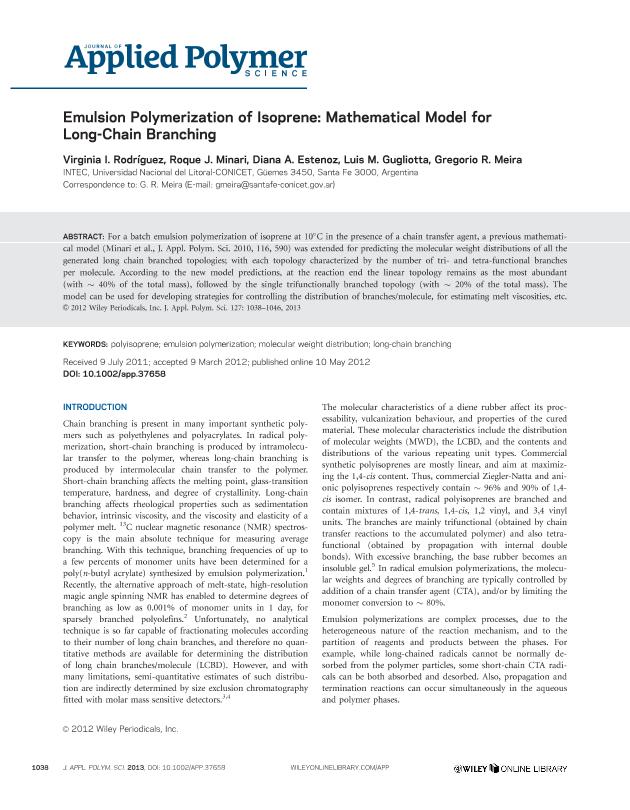Artículo
Emulsion Polymerization of Isoprene: Mathematical Model for Long Chain Branching
Rodriguez, Virginia Ines ; Minari, Roque Javier
; Minari, Roque Javier ; Estenoz, Diana Alejandra
; Estenoz, Diana Alejandra ; Gugliotta, Luis Marcelino
; Gugliotta, Luis Marcelino ; Meira, Gregorio Raul
; Meira, Gregorio Raul
 ; Minari, Roque Javier
; Minari, Roque Javier ; Estenoz, Diana Alejandra
; Estenoz, Diana Alejandra ; Gugliotta, Luis Marcelino
; Gugliotta, Luis Marcelino ; Meira, Gregorio Raul
; Meira, Gregorio Raul
Fecha de publicación:
12/2011
Editorial:
John Wiley & Sons Inc
Revista:
Journal Of Applied Polymer Science
ISSN:
0021-8995
Idioma:
Inglés
Tipo de recurso:
Artículo publicado
Clasificación temática:
Resumen
For a batch emulsion polymerization of isoprene at 10 °C in the presence of a chain transfer agent, a previous mathematical model [Minari et al., J. Appl. Polym. Sci. 2010, 116, 590] was extended for predicting the molecular weight distributions of all the generated long-branched molecular topologies; with each topology characterized by the number of tri- and tetra-functional branches per molecule. At the reaction end, and according to the new model predictions, the linear topology remains as the most abundant (with approximate 50% of the total mass), followed by the single trifunctionally-branched topology (with approximate 20% of the total mass). The model can be useful for developing strategies for controlling the distribution of branches/molec., for estimating melt viscosities, etc.
Archivos asociados
Licencia
Identificadores
Colecciones
Articulos(INTEC)
Articulos de INST.DE DES.TECNOL.PARA LA IND.QUIMICA (I)
Articulos de INST.DE DES.TECNOL.PARA LA IND.QUIMICA (I)
Citación
Rodriguez, Virginia Ines; Minari, Roque Javier; Estenoz, Diana Alejandra; Gugliotta, Luis Marcelino; Meira, Gregorio Raul; Emulsion Polymerization of Isoprene: Mathematical Model for Long Chain Branching; John Wiley & Sons Inc; Journal Of Applied Polymer Science; 127; 2; 12-2011; 1038-1046
Compartir
Altmétricas



